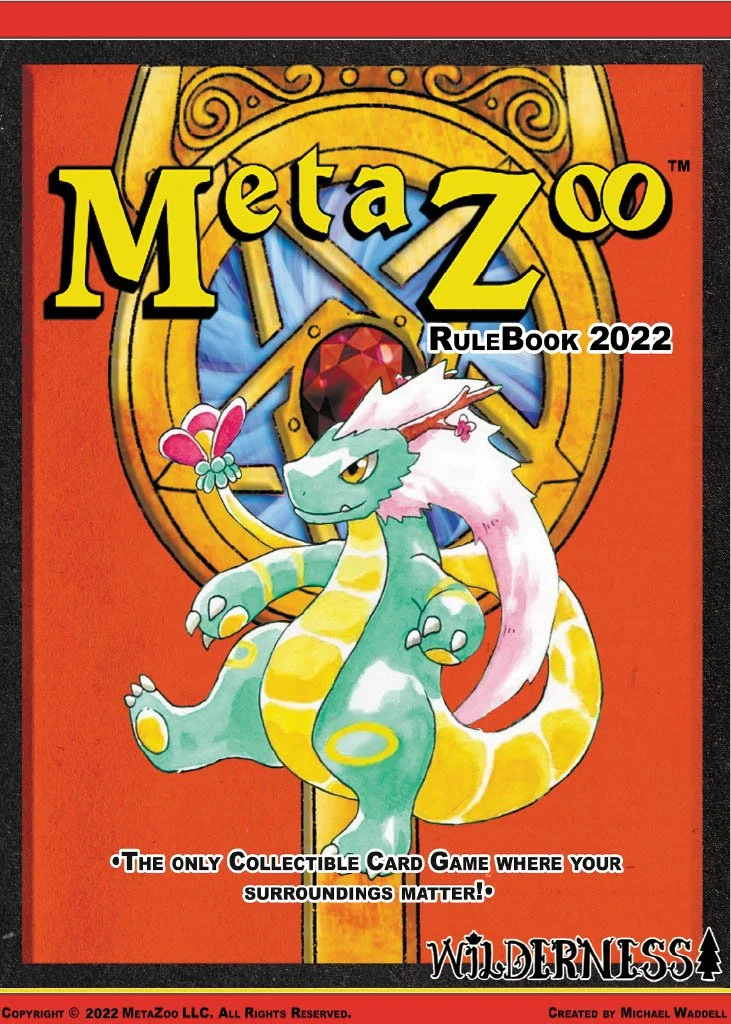https://metazoogames.com/
MetaZoo: Cryptid Nation is the new hit new TCG based on cryptids and the paranormal from across North America. It includes ‘4th wall effects,’ meaning the game plays differently when played in different places. With over 100+ cryptids, everyone has a special card that they connect with!
Role: Product Designer, Playtester, Quality Assurance
Duration: 9 Months
Tools Used: Google Sheets, Tabletop Simulator
Genre: Trading Card Game
My responsibility for MetaZoo started as a playtester for their second set, Nightfall. My work at the time included community involvement in the form of streams and Question & Answer formats every Sunday which we called MetaZooniversity. This was my idea as a way to connect to the fans of the game who wanted more practice and education on strategies provided by someone who was qualified and a trusted representative of the company. Another responsibility that I took on was being their head judge in their first national tournament in Houston Texas, Collect-A-Con. I continued my involvement with MetaZoo on their third set Wilderness. More work included Rulebook refinement, balancing cards, analyzing archetypes with the intent of strengthening and expanding mechanics and thematics unique to each type, and contributing to cost curves. The most important mission as someone who worked for MetaZoo was the high barrier of entry with such a complex card game that utilizes the environment to influence gameplay. There are many interactions that add to the complexity and it was a mission of mine to bring down the barrier of entry after seeing new players facing the same first-time user experience, something that left every new player overwhelmed with analysis paralysis. I set out to create a product that would introduce a methodical approach to two players learning the game of MetaZoo, though I had finished a version of this product, it unfortunately never made it to market. That being said, this philosophy of barrier of entry made it into some of the decks which I created for the company that did make it to market.
Headless Annie:
The first design project I took on was creating a promo and a deck for the second set of MetaZoo called Nightfall. My product would be featured as a random deck that could be used as a substitute for the draft format. The deck idea was the type of frost and flame, a deck combination I had been trying as a player before I joined the team. The archetype of flame could be summed up in a playstyle known as control through tempo. In the meta, at the time, there was a glass cannon type card that acts as an easily accessible card to draw and use to deal a lot of damage but it could be killed fairly easily. At the time, flame wasn't in the meta, so I had pushed for a ruling to make that card more apparent in the meta help add to more diversity in the meta at the time. This leads me to the creation of Headless Annie, a card with the same goal of being a glass cannon that would replace that one once environmental 4th wall effects would become more regulated. There hadn't been many conversions of burn counters into anything meaningful but swarm/spam prevention, so this was an opportunity to help contribute to a new mechanical value of flame's type.
Ijiraq:
The second official promo I designed was a beastie called Ijiraq. The idea of Ijiraq came from looking at the frost archetype and figuring out that archetype's identity, which was about control and lockdown. I felt that an enter the battlefield effect would be appropriate to fulfill this kind of "lockdown" that didn't involve the status effect of frozen. The mechanic based on this card came from the lore of this cryptid, which is that Ijiraq would appear from the fog and steal the children of northern Native American tribes. The original ideation was to have an enter the battlefield effect which caused confusion but for balancing purposes, this would have been too strong so it was settled it would have confusion on its attack.
The Decks:
Creating both decks which accompanied the promos, there were limitations on the deck which was something I had to work around with. From my Magic the Gathering drafting experience I figured that in this 40-card deck there needed to be removal and enough beasties to create a flow experience that reduced frustrations. Of course, as a designer, you want to make the best deck possible for the players to play with but accessibility was a huge concern for the experience of first-time users. Minimalizing how many different mechanics there were was something that I needed to consider when designing my decks for the public.
The biggest learnings by far from this project were cost vs benefits in a setting where the product was intended to be sold and played against other decks. Balancing these decks through the playtester team really helped me fine-tune the decks to find equilibrium amongst the other decks that were being designed. I also learned that it's important to try out the initial ideas for how you guess cards should be designed, regardless of how powerful or weak they are, then collect the data from playtesting to balance that card. There is a fine line when designing to create incentives for customer appeal and purchase of said product, in regards to horizontal power creep. This essentially means instead of making everything stronger over time by stats or effects alone, you consider design decisions that help build newer & improved identities over time. Making cards that aren't used anymore to create an ecosystem that takes older cards and gives them new meaning.









